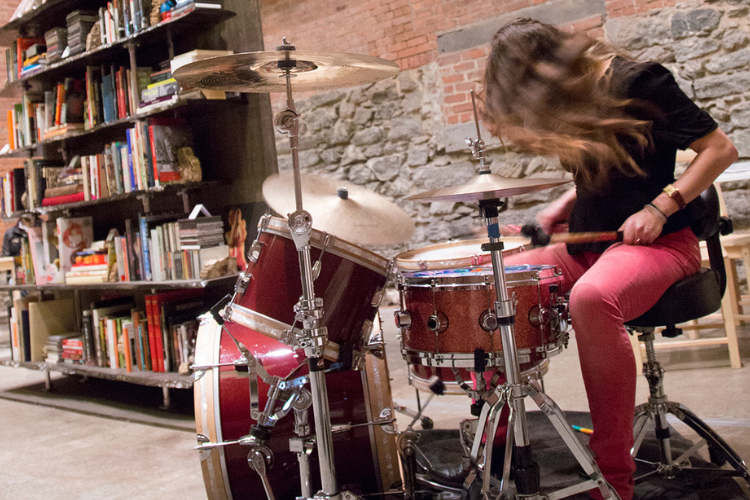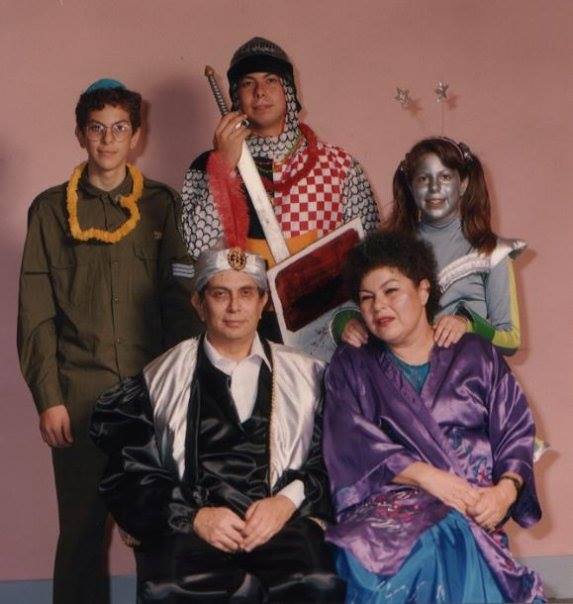
Meet the Jewish Riotgrrrl Behind the World’s Only Drumming Magazine for Women
“The drum industry has notoriously been a self-proclaimed boys club,” says Jewish Riotgrrrl Mindy Abovitz Monk — this is exactly why she decided to create Tom Tom. The magazine started as a website in 2009 and now releases quarterly issues that spotlight the voices of female and gender non-conforming drummers, percussionists and beat-makers around the globe. Lilith’s Alexa Hulse talked to Mindy Abovitz Monk about Tom Tom’s genesis, fighting for the male dollar, and dressing up as an alien for her Bat Mitzvah.
Alexa Hulse: Let’s start by talking about your Jewish and musical roots. How did it all begin?
Mindy Abovitz Monk: I went to a Modern Orthodox middle school in North Miami Beach, Florida where I learned Hebrew, Talmud, etc. At home, we were Israeli, Egyptian, Eastern European — there was a very creative mix of people who were Jewish so any expression of that was okay. Growing up, all of the holidays were very boisterous, loud, and musical; we were banging on the tables and singing and nobody felt they had to reserve themselves — that was my very basic musical background. Moving into being a teenager and being introduced to Riot Grrrl, I immediately wanted to be in a band. Eventually that led to me drumming in my early 20s and starting the only drumming magazine for women in the world, Tom Tom, when I was 29.
AH: Could you tell me more about how Tom Tom came to be?
MAM: When I was in high school I was deeply attracted to the Riot Grrrl movement, which was a bunch of girls and young women playing really loudly and unapologetically on their instruments and scream-singing lyrics that mattered to them. For the first time in my life I felt like I could be a musician. I played the drums for almost a decade, seeking out other women and girls to play with. After throwing hundreds of shows at my loft in Brooklyn and going on tour with my all-girl band, I came full circle to feeling the desire and draw to Riot Grrrl that I felt when I was a teenager. We were still needing to hear from powerful girls and women, to allow other girls and women to play instruments.
I started Tom Tom Magazine in 2009 to pay respect to the existing drummers that were there and to pave the way for new drummers, specifically female and GNC (gender non-comforming) drummers, percussionists, and beat-makers around the world. It started with a website, then we quickly started printing a magazine; 11 years later, it’s 76 pages, full-color, and distributed globally. My desire in 2009 was to rekindle the Riot Grrrl spirit but I wanted to do it above ground and use the male dollar as part of my activism. I wanted the drum industry to recognize us as actual drummers. I think I made a dent, I’m still working on it.
AH: The male dollar?
MAM: I knew from the start that all of our advertising dollars were going to come from the drum industry. I didn’t want to get advertising dollars from the fashion industry or the beauty industry because that goes against my ethos—because we are a music magazine, we should have music ads. The drum industry is run by men, they didn’t think female drummers existed, of course they weren’t interested in putting advertising dollars into our magazine. It has been awesome to pry open the drum industry and get them to pay us. Some of them have with ease, some of them have with great difficulty, and a lot of them still have not. They can hide behind saying “It’s not a big enough demographic” or “It’s too racy.” I think it is all an excuse. My drive was to get the male dollar because that is, unfortunately, the drum dollar.
AH: What financial challenges have you faced in this endeavor?
MAM: Well, if they aren’t scared of us because we are female, they are terrified of a female who is proud, secure, and loud about her sexuality. We are musicians, we fall in and out of love, we’re on the road, we’re touring with our bandmates (who are also our partners or ex-lovers). These are the stories we told in our Sex and Love Issue, and it was too scary for many men in the drum industry. Once they had agreed to let us in, there were terms: you gotta be polite, you gotta act like a dude, and then you can be here. If you’re going to talk about tits or your period or your crush, you’re not allowed. That was basically the message I got (loud and clear) because we got over $100,000 worth of advertising pulled just because of that issue.
AH: What role, if any, does Judaism play in Tom Tom?
MAM: Up front, Judaism does not play a huge role — but behind the scenes, it informs everything. I believe that my deep desire for there to be equality in the world and for everyone’s voices to be heard is directly connected to my Jewish identity. I can tell you that if I wasn’t raised Jewish, I wouldn’t care as deeply and as much as I do about equality. Tom Tom is 100% about leveling the playing field for all of us.
One of the funny things is that I have been kind of pointed at as “the rebellious one” in my family but that is being Jewish. I’ve learned all of that from Judaism — to ask questions and demand answers. I think the fabric of Judaism leans heavily into shaking stuff up and making sure that everyone is looked after; I feel so proud of that. The more I look around at the other Jewish folks who are also fighting the good fight, I’m like, “Okay, we all really care about this and it isn’t just an accident.”
AH: When did your said rebellious streak start?
MAM: Probably when I dressed up like an alien at my Bat Mitzvah…I think it had something to do with the fact that I had two older brothers and a large family full of boys who were all Bar Mitzvahed. I felt left out in Judaism and it came through in my decision to wear green and silver face paint that day. That was all just to say “I’m here, but I am also an alien. I am here at this event, mostly for you all, letting you know that I feel left out.” Recently I had some conversations with friends from that point in my life and they were like “I remember when you did that, it really helped me kind of understand what I wasn’t able to verbalize back then.”

AH: That’s so iconic. What advice would you give to young creatives looking for spaces of belonging?
MAM: I would advise them to do something similar to what I did. I created what I wanted to see that wasn’t there. If you’re not feeling that brave, do it with a friend, figure out what strengths you have, what strengths they have, and come together to build the project yourself. The power that the younger generation holds is so much larger than anyone ever lets on. Everyone is always like, “Oh what do you want to be when you grow up? You still need to get this experience and do this internship.” The reality is people my age and older are terrified of younger generations because of how much they know, so my advice is to be unapologetic in what you know to be true when it comes to justice. Don’t accept anything less than what you deserve.
AH: That is really great advice, thank you. Last question — who is your favorite drummer?
MAM: I never answer that question because I have too many… Can I say everyone who is brave enough to get behind the drum set who wasn’t invited?
AH: Absolutely.
Find Mindy Here:
Instagram: @tomtommag
Website: https://tomtommag.com/
Shop: https://shop.tomtommag.com/
Alexa Hulse (she/they) is a sophomore at Hollins University. She studies Gender and Women’s Studies and Studio Art. Alexa is Lilith’s current social media and archival intern and you can find them on Instagram @alexabhulse and @t00.soft.



